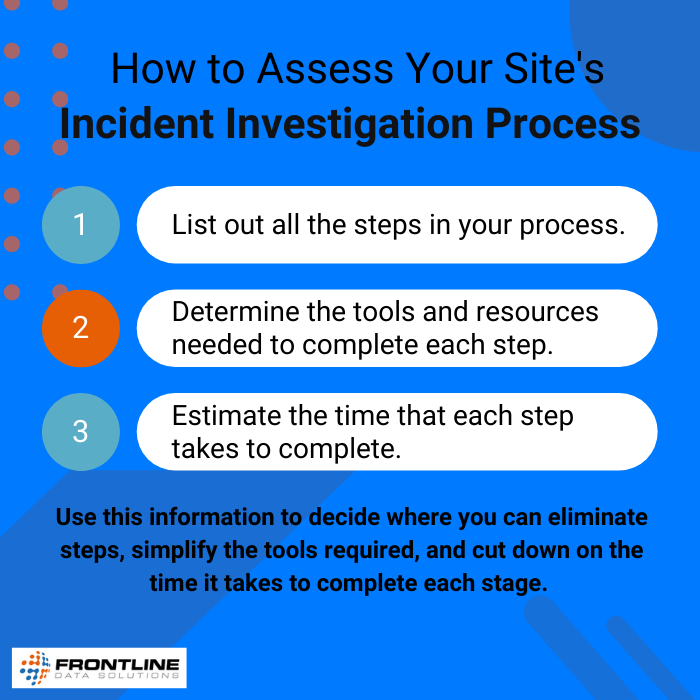Getting managers more involved in incident investigation
Having a complicated incident investigation process is one of the easiest ways to alienate managers. If it takes up too much of their time, managers will produce low-quality reports. And this will have a long-term impact on the operation.
Reviewing your current process
If you’re unsure where to make improvements, start by making a list of all the steps in your EHS team’s investigation process. Include actions like:
- Collecting witness statements
- Reviewing video footage
- Following up with designated treatment facilities
- Taking photos of the scene
- Doing root cause analysis
Then, go through the list and add all the tools and resources (including people) that your team needs to complete each step.
Finally, estimate the amount of time each step takes.
After going through this process, you’ll have a better idea of how complex your incident investigation process is. And you’ll have an easier time simplifying it.
Below are my top recommendations for improving your incident investigation process so that managers are more engaged. Based on my time as an operations manager, these suggestions are designed to provide better support to managers who are already short of time.
With these improvements, you can produce better incident reports without over-complicating the process. And you might strengthen the EHS department’s relationship with other teams throughout the site as well.

Encouraging collaboration
For an operation to run well, all departments need to work together towards a common goal. Worker safety, among other operational goals, is easiest to achieve when you value the input of all stakeholders in a process change.
Encouraging collaboration across departments can look like:
- Asking managers about proposed changes to processes and systems
- Training all managers in workers’ daily tasks and responsibilities
- Involving people at all levels of the business in safety walks and GEMBA meetings
- Holding regular meetings between different departments to discuss sitewide safety
At my site, the EHS team would always come to the floor and have the manager walk them through the process. They would ask questions about what the employee was trying to do when they got injured. This gave them more details to use in their incident reports.
Depending on how busy the EHS team was, they would often lean on managers to help write incident descriptions. And managers almost always had the opportunity (or responsibility) to provide a 5 why analysis of the event.
If you don’t regularly involve managers in the investigation process, they won’t see it as a benefit to their team’s performance. This weakens the site’s safety culture. And it ultimately treats quality and productivity goals as separate from safety initiatives. That’s why collaboration can increase the effectiveness of any actions that come from an incident investigation.
Using a digital reporting system
A user-friendly investigation process is one that values managers’ time. Using paper forms, emails, Excel and Word documents, and any combination of these approaches can ruin the experience.
At my site, we used EHS data management software to make, create, and update our incident investigations. This meant that I could help the EHS team from my work area instead of having to get on the phone or go to their office to provide my input. As a manager, I used the EHS software to:
- Upload photos to incident reports
- Write and record incident descriptions
- Give recommendations for next steps
- Create and complete action items
- Update investigation documents with new information/details
- Set timelines for the completion of action items
Due to the size of our operations, we really couldn’t afford to not have a digital reporting system. We simply couldn’t manage all the incident information by hand.
At the end of the day, having everything in a digital format saved me time trying to help the EHS team. And if the process had taken any more time, I probably wouldn’t have wanted to be part of incident investigations at all.
Providing helpful resources
Many managers are go-getters, meaning they will teach themselves a good amount if given the right resources. Some of the best and simplest resources that helped me to improve my incident investigation skills were things like notes on incident descriptions that I’d written and easy-to-use 5 why templates.
Sending managers helpful resources when you come across them helps build a strong safety culture. It also sends the message that you’re interested in their development and success—especially when it comes to safety initiatives.
Whether a blog post, a checklist, a form—I was always more motivated to do a better deep dive when I felt it was achievable. Having tools and resources helped me sharpen my investigation skills. And eventually I was able to use techniques that the safety team taught me for other areas like process and quality improvements.
All in all, I would say that doing incident investigations made me more aware of how safety impacted the health and performance of my team. And it also made me better at engaging with my team on safety-related topics. This helped me build a real relationship with the people under my care and developed a mutual respect that helped propel our department towards other operational goals.
But I wouldn’t have gotten there without the EHS team’s continuous support and involvement regarding the investigation process. Working together to understand incidents and come up with long-term solutions made me appreciate the role of thorough investigation. And at the end of the day, that’s the kind of stance you want your managers to take towards safety as a whole.



